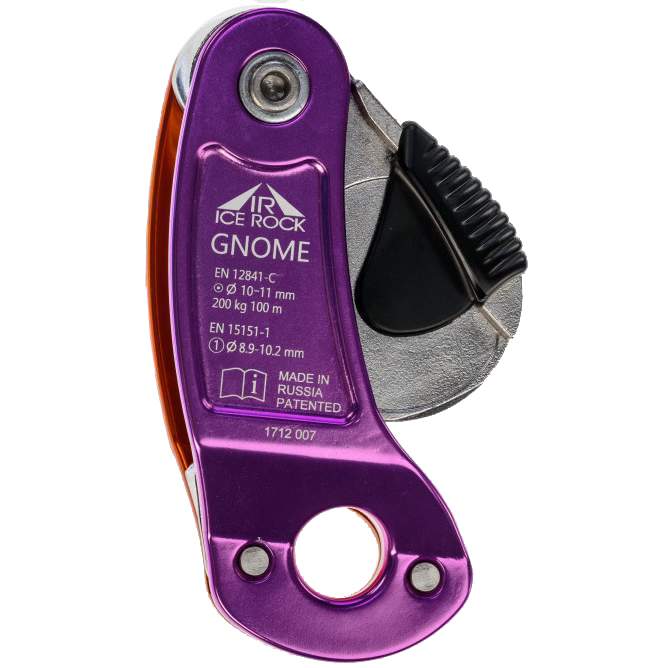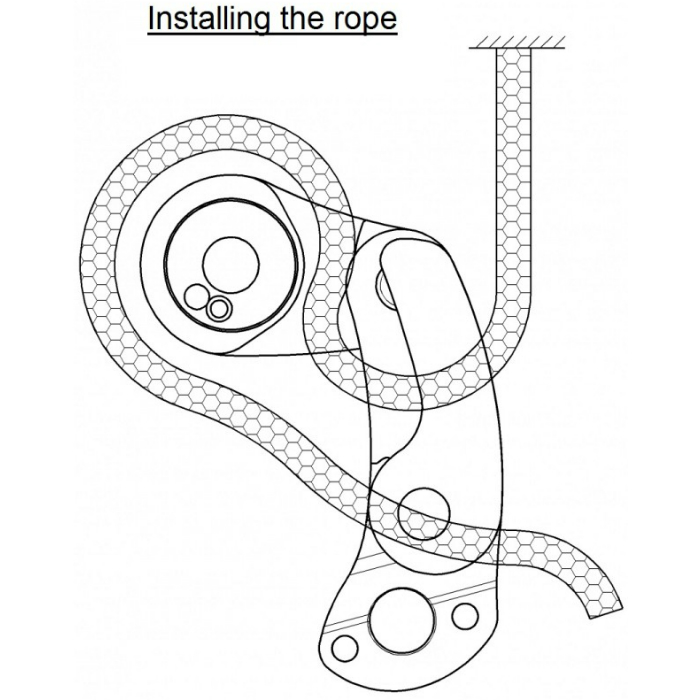Gnome Second Edition
Description
The second edition of GNOME descender has the following improvements:
- hot forged side plates for better ergonomics;
- a steel plate in the area of most intensive friction for a longer lifespan;
- a plastic patch on a cam for a more convenient belay;
- the cam opens only for 90° for easier rope installation.
GNOME is a truly revolutionary descending and belay device. An innovative adaptation system, which adjusts to the user’s weight and rope diameter has been incorporated in this design, which is the first of its kind in the world.
This system:
-ensures a precise and smooth descent control with a fraction of normal applied force to its handle, allowing for ‘one-finger effort’;
-works on a wide range of rope diameters (8,9...11) without a loss of quality in descent and belay;
-allows to combine functionality of a descender and a belay device.
GNOME:
- provides a precise, smooth and reliable descent control;
- makes "one-handed" descent possible;
- is compatible with many differing carabiner shapes.
- doesn't need to take out a carabiner to install the rope;
- doesn't twist a rope;
- decreases rope wear;
- is compact and light.
The cam and the clamping surface area are manufactured from high grade steel. Inside the cam there is a hidden high-precision mechanism made from high-grade steel which has only a few microns of tolerance.
Gradual cam engagement decreases the force of fall and rope wear in case of accidental free-fall.
GNOME is one of the lightest compact devices among auto-blocking belay devices. Maximum working load is 200 kg.
The device is designed to reduce the possibility of a belayer panicking: when the rope is blocked, the handle remains steady.
The device’s body design makes it compatible with many differing carabiner shapes.
GNOME design is patented (# 147130 from 26.06.2014). It took 7 years to design and test the device.
Device Type  Device TypeTubeThe most commonly used belay type also called an “ATC” or “tuber.” Other than a distinction between other belay device types, “Tube” is a rarely used term, most climbers just assume you're talking about this style when they refer to your "belay device." 
Figure 8Mostly used in rescue, canyoneering, tactical, work safety, or by old school climbers and rappellers. One reason they went out of popularity with recreational climbers is because they tend to create twists in the rope. 
Brake AssistThese devices assist in stopping the rope when a climber falls or hangs on the rope. 
Often referred to as “auto-blocking” but that’s not the official terminology because no belay device should be assumed to work automatically by itself, even if it feels like it does (or does most the time). PlateWhen simplicity is a must, or you started climbing before Tubers were the norm. Bonus: They tend to be very light weight. 
DescenderFor rappelling, not for belaying a lead climber or top-roping.  |
Brake Assist - Mechanical |
Weight (g)  Weight (g)In grams, the weight, as stated by the manufacturer/brand. |
305 g |
Belay Brake Assist  Belay Brake AssistThis is when the belay device significantly reduces the amount of holding power the belayer must exert to stop a fall and hold a climber. This is also called "assisted-braking" as the device must hold a significant amount of the climber’s weight; this term does not include friction-adding "teeth" found on some tube style belay devices. Confusingly referred to as “auto-blocking” or “auto-locking” these terms wrongly imply the device will always, automatically, stop a fall or hold a climber even if the belayer/rappeller is hands-free. These devices are not meant to be used without a hand on the braking side of the rope; the belayers/rapppeller brake hand should always be on the brake rope. Worth ConsideringMost of the mechanical brake assist devices only hold a single strand of rope and are not capable of double-strand rappelling (the most common method of rappel). |
Yes |
| Rope Options | 1 rope only |
Guide Mode  Guide ModeThis is when you belay directly off the anchor instead of your harness. Guide mode is helpful if you climb outdoors a lot because it reduces the holding power required from the belayer. When your partner falls or rests, the weight of the climber is held mostly by the anchor and the belay device. Tubers and PlatesWhen belaying in "guide mode," the tubers and plates turn auto-blocking. During a fall, the climbing rope pinches the slack rope, completely stopping the movement of either rope. A common guide mode setup shown below. 
Mechanical Brake Assist DevicesThere is no difference in the functionality of the device. A brake-hand should always be on the rope to ensure the climber is caught in the case of a fall. A common guide mode setup shown below. 
Where guide mode is used
Learn Morehttp://www.climbing.com/skill/essential-skills-auto-blocking-belay-devices/ |
No guide mode |
Teeth  TeethTeeth are only seen on tube devices. They add friction that helps grip the rope for more belaying control. This is helpful for belaying heavier climbers. Teeth are becoming standard on new tube devices. 
Worth ConsideringTeeth do wear out. You can limit wear by rappelling on the side without teeth (if you don’t need the extra friction). Once they’re worn, you’ll still have a usable belay device, just less friction. |
No |
Rope Range (mm)  Rope Range (mm)The range of rope diameters, in millimeters, that the manufacturer/brand specifies can safely be used. This is the best case scenario and does not necessarily take into consideration that certified ropes have a tolerance of +/- .3 mm. Recently, manufacturers have started to add an "optimized" rope range -- this is the range that will result in the nicest handling of the belay device. | 8.9 mm - 10.2 mm |
Certification  CertificationsThe main climbing gear certifications are CE and UIAA--and normally the UIAA creates the rules that the CE body also supports. When possible, we try to list all the certifications the product carries. To sell a climbing product in Europe, the device must be CE certified. There are no official requirements to sell climbing gear in the US. The UIAA certification is a voluntary process. Learn MoreRock and Ice Certifications Guide |
CE, EN |
No reviews yet.





















